Comanche vs Russian Community Comparison
COMPARE
Comanche
Russian
Social Comparison
Social Comparison
Comanche
Russians
1,908
SOCIAL INDEX
16.6/ 100
SOCIAL RATING
283rd/ 347
SOCIAL RANK
8,595
SOCIAL INDEX
83.4/ 100
SOCIAL RATING
62nd/ 347
SOCIAL RANK
Russian Integration in Comanche Communities
The statistical analysis conducted on geographies consisting of 106,701,034 people shows a poor negative correlation between the proportion of Russians within Comanche communities in the United States with a correlation coefficient (R) of -0.126. On average, for every 1% (one percent) increase in Comanche within a typical geography, there is a decrease of 0.018% in Russians. To illustrate, in a geography comprising of 100,000 individuals, a rise of 1,000 Comanche corresponds to a decrease of 17.7 Russians.
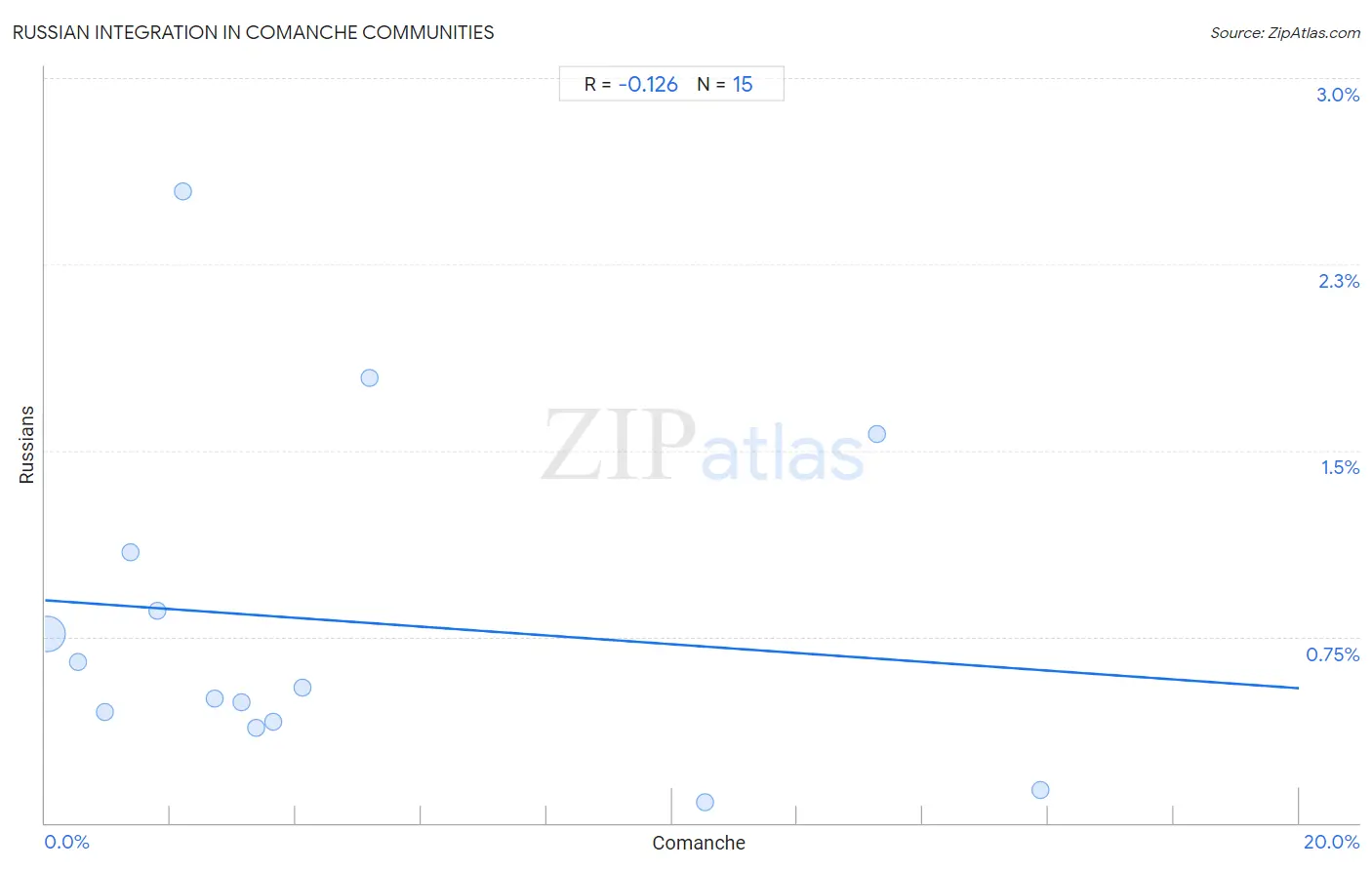
Comanche vs Russian Income
When considering income, the most significant differences between Comanche and Russian communities in the United States are seen in per capita income ($38,088 compared to $53,154, a difference of 39.6%), median family income ($88,556 compared to $120,487, a difference of 36.1%), and householder income ages 45 - 64 years ($85,787 compared to $116,328, a difference of 35.6%). Conversely, both communities are more comparable in terms of wage/income gap (25.0% compared to 28.0%, a difference of 11.8%), householder income under 25 years ($47,518 compared to $54,389, a difference of 14.5%), and householder income over 65 years ($54,922 compared to $67,626, a difference of 23.1%).

| Income Metric | Comanche | Russian |
| Per Capita Income | Tragic $38,088 | Exceptional $53,154 |
| Median Family Income | Tragic $88,556 | Exceptional $120,487 |
| Median Household Income | Tragic $73,747 | Exceptional $98,008 |
| Median Earnings | Tragic $41,519 | Exceptional $53,334 |
| Median Male Earnings | Tragic $48,202 | Exceptional $63,939 |
| Median Female Earnings | Tragic $35,661 | Exceptional $44,169 |
| Householder Age | Under 25 years | Tragic $47,518 | Exceptional $54,389 |
| Householder Age | 25 - 44 years | Tragic $82,152 | Exceptional $110,398 |
| Householder Age | 45 - 64 years | Tragic $85,787 | Exceptional $116,328 |
| Householder Age | Over 65 years | Tragic $54,922 | Exceptional $67,626 |
| Wage/Income Gap | Excellent 25.0% | Tragic 28.0% |
Comanche vs Russian Poverty
When considering poverty, the most significant differences between Comanche and Russian communities in the United States are seen in family poverty (11.0% compared to 7.5%, a difference of 48.2%), child poverty under the age of 16 (19.9% compared to 13.5%, a difference of 47.4%), and child poverty among boys under 16 (20.1% compared to 13.8%, a difference of 45.8%). Conversely, both communities are more comparable in terms of seniors poverty over the age of 75 (12.8% compared to 11.6%, a difference of 10.1%), single father poverty (18.5% compared to 16.4%, a difference of 12.3%), and seniors poverty over the age of 65 (12.1% compared to 10.0%, a difference of 20.6%).
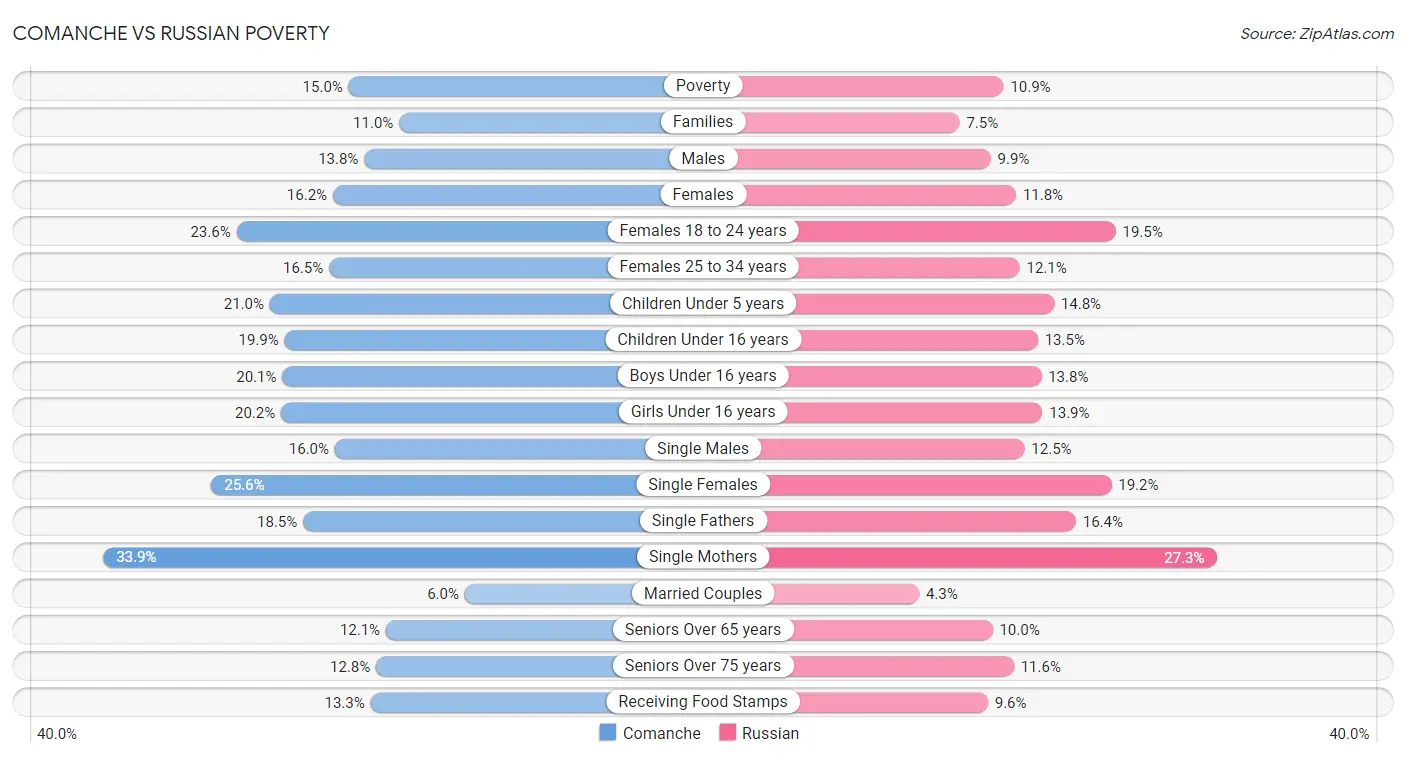
| Poverty Metric | Comanche | Russian |
| Poverty | Tragic 15.0% | Exceptional 10.9% |
| Families | Tragic 11.0% | Exceptional 7.5% |
| Males | Tragic 13.8% | Exceptional 9.9% |
| Females | Tragic 16.2% | Exceptional 11.8% |
| Females 18 to 24 years | Tragic 23.6% | Exceptional 19.5% |
| Females 25 to 34 years | Tragic 16.5% | Exceptional 12.1% |
| Children Under 5 years | Tragic 21.0% | Exceptional 14.8% |
| Children Under 16 years | Tragic 19.9% | Exceptional 13.5% |
| Boys Under 16 years | Tragic 20.1% | Exceptional 13.8% |
| Girls Under 16 years | Tragic 20.2% | Exceptional 13.9% |
| Single Males | Tragic 16.0% | Excellent 12.5% |
| Single Females | Tragic 25.6% | Exceptional 19.2% |
| Single Fathers | Tragic 18.5% | Fair 16.4% |
| Single Mothers | Tragic 33.9% | Exceptional 27.3% |
| Married Couples | Tragic 6.0% | Exceptional 4.3% |
| Seniors Over 65 years | Tragic 12.1% | Exceptional 10.0% |
| Seniors Over 75 years | Tragic 12.8% | Excellent 11.6% |
| Receiving Food Stamps | Tragic 13.3% | Exceptional 9.6% |
Comanche vs Russian Unemployment
When considering unemployment, the most significant differences between Comanche and Russian communities in the United States are seen in unemployment among seniors over 75 years (6.7% compared to 8.9%, a difference of 33.0%), unemployment among women with children under 18 years (6.1% compared to 5.1%, a difference of 20.6%), and unemployment among ages 25 to 29 years (7.8% compared to 6.6%, a difference of 17.8%). Conversely, both communities are more comparable in terms of unemployment among youth under 25 years (11.8% compared to 11.6%, a difference of 2.4%), unemployment among ages 60 to 64 years (5.0% compared to 4.9%, a difference of 2.5%), and unemployment among ages 20 to 24 years (10.2% compared to 10.4%, a difference of 2.7%).
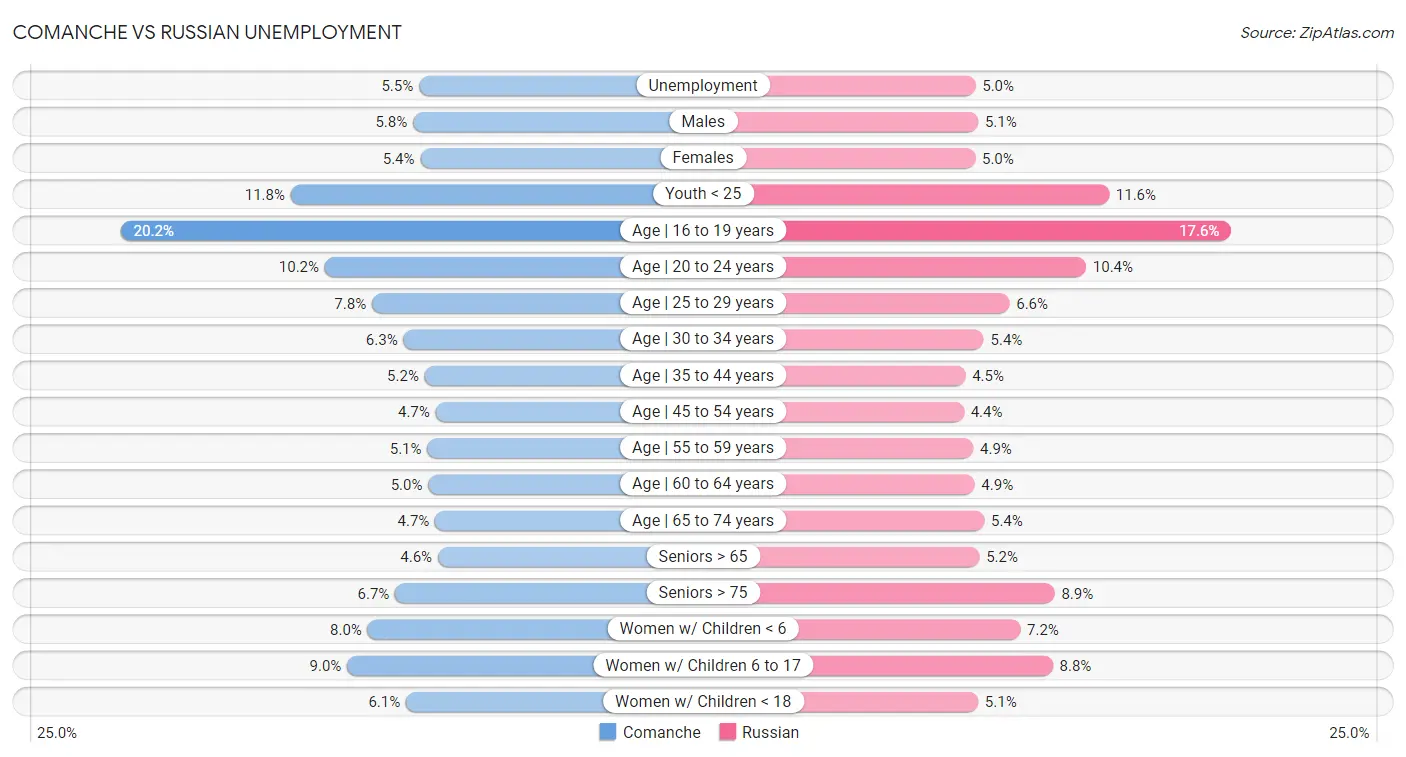
| Unemployment Metric | Comanche | Russian |
| Unemployment | Tragic 5.5% | Exceptional 5.0% |
| Males | Tragic 5.8% | Exceptional 5.1% |
| Females | Poor 5.4% | Exceptional 5.0% |
| Youth < 25 | Poor 11.8% | Average 11.6% |
| Age | 16 to 19 years | Tragic 20.2% | Average 17.6% |
| Age | 20 to 24 years | Excellent 10.2% | Fair 10.4% |
| Age | 25 to 29 years | Tragic 7.8% | Average 6.6% |
| Age | 30 to 34 years | Tragic 6.3% | Good 5.4% |
| Age | 35 to 44 years | Tragic 5.2% | Exceptional 4.5% |
| Age | 45 to 54 years | Tragic 4.7% | Exceptional 4.4% |
| Age | 55 to 59 years | Tragic 5.1% | Fair 4.9% |
| Age | 60 to 64 years | Tragic 5.0% | Poor 4.9% |
| Age | 65 to 74 years | Exceptional 4.7% | Fair 5.4% |
| Seniors > 65 | Exceptional 4.6% | Average 5.2% |
| Seniors > 75 | Exceptional 6.7% | Fair 8.9% |
| Women w/ Children < 6 | Tragic 8.0% | Exceptional 7.2% |
| Women w/ Children 6 to 17 | Fair 9.0% | Excellent 8.8% |
| Women w/ Children < 18 | Tragic 6.1% | Exceptional 5.1% |
Comanche vs Russian Labor Participation
When considering labor participation, the most significant differences between Comanche and Russian communities in the United States are seen in in labor force | age 45-54 (79.2% compared to 83.4%, a difference of 5.3%), in labor force | age 35-44 (81.5% compared to 85.0%, a difference of 4.3%), and in labor force | age 25-29 (81.9% compared to 85.3%, a difference of 4.3%). Conversely, both communities are more comparable in terms of in labor force | age 20-24 (75.4% compared to 74.8%, a difference of 0.73%), in labor force | age > 16 (63.6% compared to 64.9%, a difference of 1.9%), and in labor force | age 16-19 (37.7% compared to 36.7%, a difference of 2.7%).

| Labor Participation Metric | Comanche | Russian |
| In Labor Force | Age > 16 | Tragic 63.6% | Poor 64.9% |
| In Labor Force | Age 20-64 | Tragic 77.0% | Exceptional 80.0% |
| In Labor Force | Age 16-19 | Exceptional 37.7% | Average 36.7% |
| In Labor Force | Age 20-24 | Good 75.4% | Fair 74.8% |
| In Labor Force | Age 25-29 | Tragic 81.9% | Exceptional 85.3% |
| In Labor Force | Age 30-34 | Tragic 82.6% | Exceptional 85.5% |
| In Labor Force | Age 35-44 | Tragic 81.5% | Exceptional 85.0% |
| In Labor Force | Age 45-54 | Tragic 79.2% | Exceptional 83.4% |
Comanche vs Russian Family Structure
When considering family structure, the most significant differences between Comanche and Russian communities in the United States are seen in single mother households (7.0% compared to 5.3%, a difference of 33.1%), births to unmarried women (36.7% compared to 28.0%, a difference of 31.0%), and single father households (2.5% compared to 2.0%, a difference of 26.3%). Conversely, both communities are more comparable in terms of family households (63.5% compared to 63.4%, a difference of 0.13%), average family size (3.25 compared to 3.12, a difference of 4.1%), and family households with children (27.6% compared to 26.5%, a difference of 4.1%).

| Family Structure Metric | Comanche | Russian |
| Family Households | Tragic 63.5% | Tragic 63.4% |
| Family Households with Children | Good 27.6% | Tragic 26.5% |
| Married-couple Households | Tragic 44.5% | Exceptional 48.2% |
| Average Family Size | Excellent 3.25 | Tragic 3.12 |
| Single Father Households | Tragic 2.5% | Exceptional 2.0% |
| Single Mother Households | Tragic 7.0% | Exceptional 5.3% |
| Currently Married | Tragic 45.0% | Exceptional 48.6% |
| Divorced or Separated | Tragic 13.5% | Exceptional 11.5% |
| Births to Unmarried Women | Tragic 36.7% | Exceptional 28.0% |
Comanche vs Russian Vehicle Availability
When considering vehicle availability, the most significant differences between Comanche and Russian communities in the United States are seen in 4 or more vehicles in household (6.8% compared to 6.0%, a difference of 13.6%), no vehicles in household (10.2% compared to 11.6%, a difference of 13.2%), and 3 or more vehicles in household (21.0% compared to 18.8%, a difference of 11.3%). Conversely, both communities are more comparable in terms of 1 or more vehicles in household (89.9% compared to 88.7%, a difference of 1.4%), 2 or more vehicles in household (56.5% compared to 54.8%, a difference of 3.1%), and 3 or more vehicles in household (21.0% compared to 18.8%, a difference of 11.3%).

| Vehicle Availability Metric | Comanche | Russian |
| No Vehicles Available | Good 10.2% | Tragic 11.6% |
| 1+ Vehicles Available | Good 89.9% | Tragic 88.7% |
| 2+ Vehicles Available | Excellent 56.5% | Fair 54.8% |
| 3+ Vehicles Available | Exceptional 21.0% | Poor 18.8% |
| 4+ Vehicles Available | Exceptional 6.8% | Poor 6.0% |
Comanche vs Russian Education Level
When considering education level, the most significant differences between Comanche and Russian communities in the United States are seen in professional degree (3.5% compared to 6.3%, a difference of 79.2%), doctorate degree (1.6% compared to 2.6%, a difference of 62.5%), and master's degree (12.1% compared to 19.5%, a difference of 61.6%). Conversely, both communities are more comparable in terms of nursery school (98.0% compared to 98.4%, a difference of 0.37%), kindergarten (98.0% compared to 98.4%, a difference of 0.37%), and 1st grade (98.0% compared to 98.3%, a difference of 0.38%).
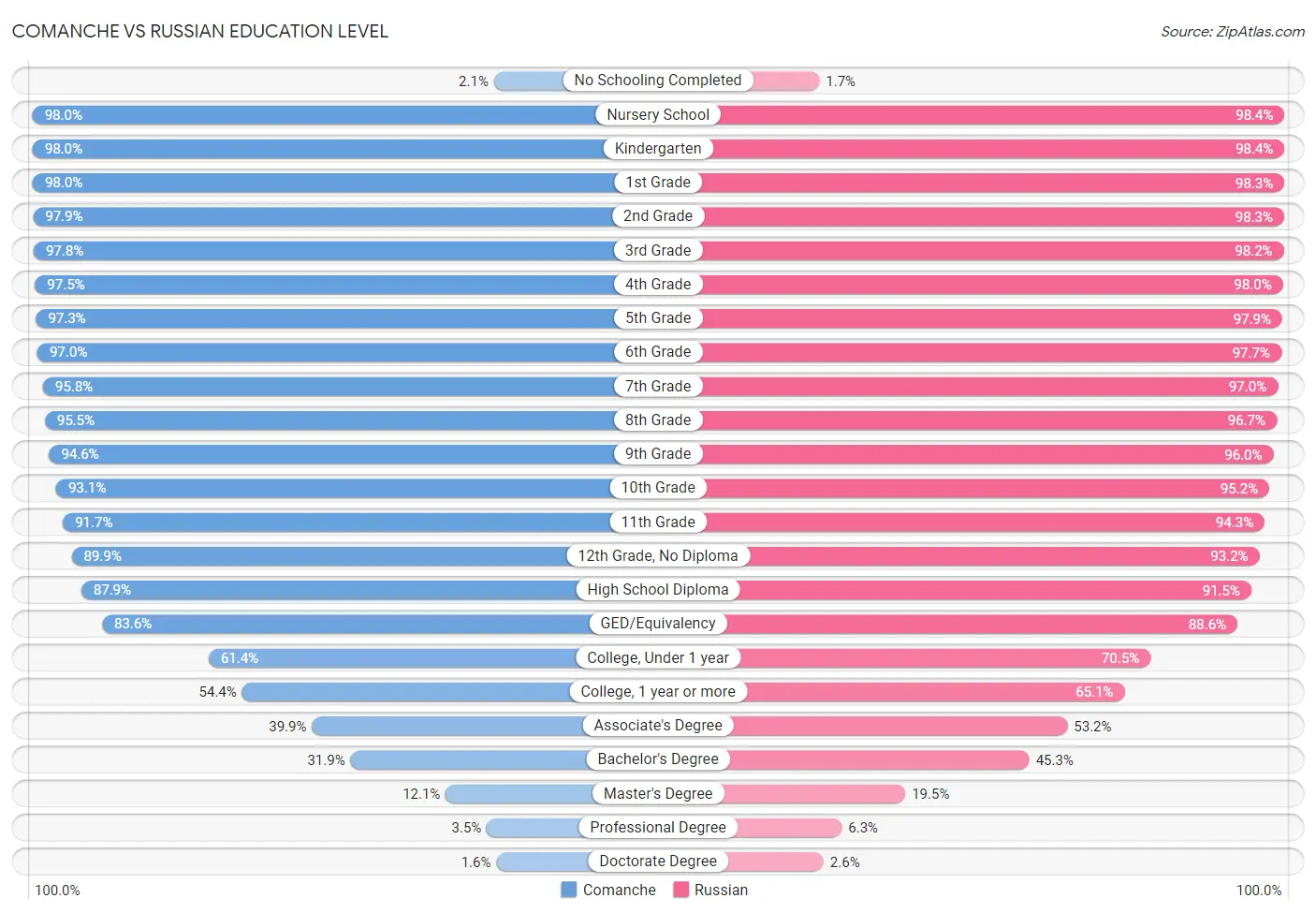
| Education Level Metric | Comanche | Russian |
| No Schooling Completed | Good 2.1% | Exceptional 1.7% |
| Nursery School | Good 98.0% | Exceptional 98.4% |
| Kindergarten | Good 98.0% | Exceptional 98.4% |
| 1st Grade | Good 98.0% | Exceptional 98.3% |
| 2nd Grade | Good 97.9% | Exceptional 98.3% |
| 3rd Grade | Average 97.8% | Exceptional 98.2% |
| 4th Grade | Average 97.5% | Exceptional 98.0% |
| 5th Grade | Average 97.3% | Exceptional 97.9% |
| 6th Grade | Fair 97.0% | Exceptional 97.7% |
| 7th Grade | Fair 95.8% | Exceptional 97.0% |
| 8th Grade | Poor 95.5% | Exceptional 96.7% |
| 9th Grade | Poor 94.6% | Exceptional 96.0% |
| 10th Grade | Tragic 93.1% | Exceptional 95.2% |
| 11th Grade | Tragic 91.7% | Exceptional 94.3% |
| 12th Grade, No Diploma | Tragic 89.9% | Exceptional 93.2% |
| High School Diploma | Tragic 87.9% | Exceptional 91.5% |
| GED/Equivalency | Tragic 83.6% | Exceptional 88.6% |
| College, Under 1 year | Tragic 61.4% | Exceptional 70.5% |
| College, 1 year or more | Tragic 54.4% | Exceptional 65.1% |
| Associate's Degree | Tragic 39.9% | Exceptional 53.2% |
| Bachelor's Degree | Tragic 31.9% | Exceptional 45.3% |
| Master's Degree | Tragic 12.1% | Exceptional 19.5% |
| Professional Degree | Tragic 3.5% | Exceptional 6.3% |
| Doctorate Degree | Tragic 1.6% | Exceptional 2.6% |
Comanche vs Russian Disability
When considering disability, the most significant differences between Comanche and Russian communities in the United States are seen in disability age 35 to 64 (14.7% compared to 10.2%, a difference of 44.9%), vision disability (2.8% compared to 2.0%, a difference of 40.6%), and disability age 65 to 74 (28.3% compared to 21.2%, a difference of 34.0%). Conversely, both communities are more comparable in terms of disability age under 5 (1.2% compared to 1.4%, a difference of 10.1%), cognitive disability (18.6% compared to 16.4%, a difference of 13.4%), and disability age over 75 (51.7% compared to 45.5%, a difference of 13.6%).
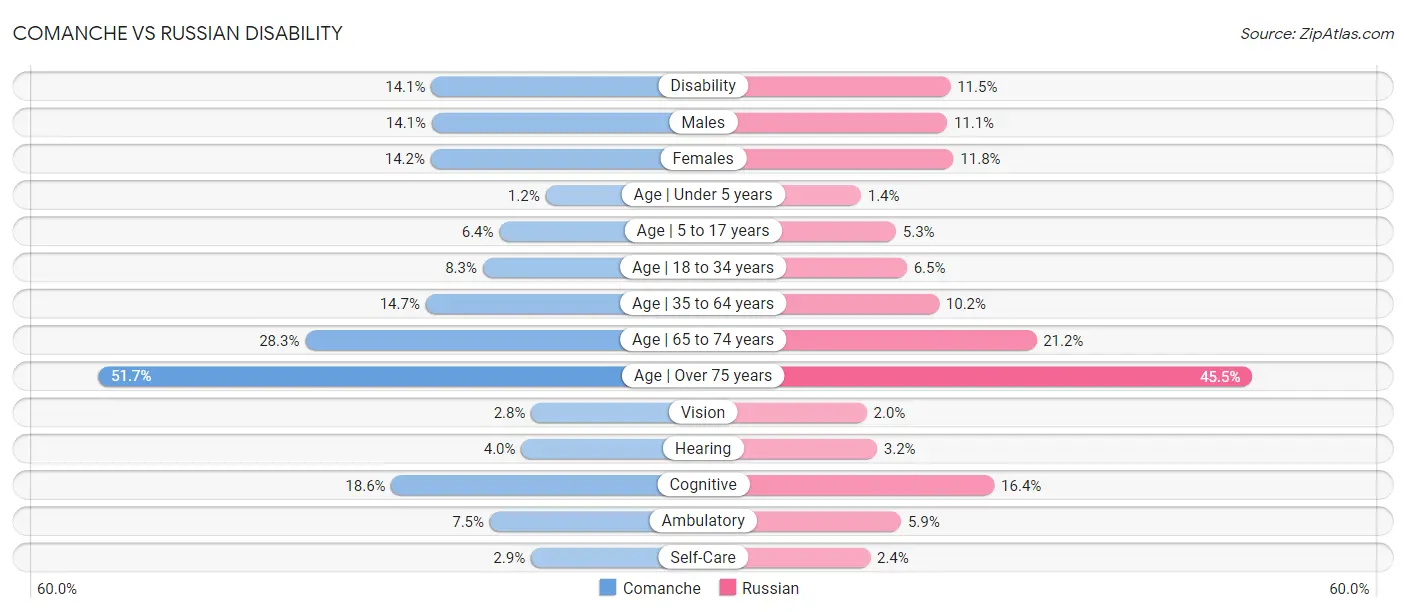
| Disability Metric | Comanche | Russian |
| Disability | Tragic 14.1% | Excellent 11.5% |
| Males | Tragic 14.1% | Good 11.1% |
| Females | Tragic 14.2% | Exceptional 11.8% |
| Age | Under 5 years | Average 1.2% | Tragic 1.4% |
| Age | 5 to 17 years | Tragic 6.4% | Exceptional 5.3% |
| Age | 18 to 34 years | Tragic 8.3% | Good 6.5% |
| Age | 35 to 64 years | Tragic 14.7% | Exceptional 10.2% |
| Age | 65 to 74 years | Tragic 28.3% | Exceptional 21.2% |
| Age | Over 75 years | Tragic 51.7% | Exceptional 45.5% |
| Vision | Tragic 2.8% | Exceptional 2.0% |
| Hearing | Tragic 4.0% | Tragic 3.2% |
| Cognitive | Tragic 18.6% | Exceptional 16.4% |
| Ambulatory | Tragic 7.5% | Exceptional 5.9% |
| Self-Care | Tragic 2.9% | Excellent 2.4% |